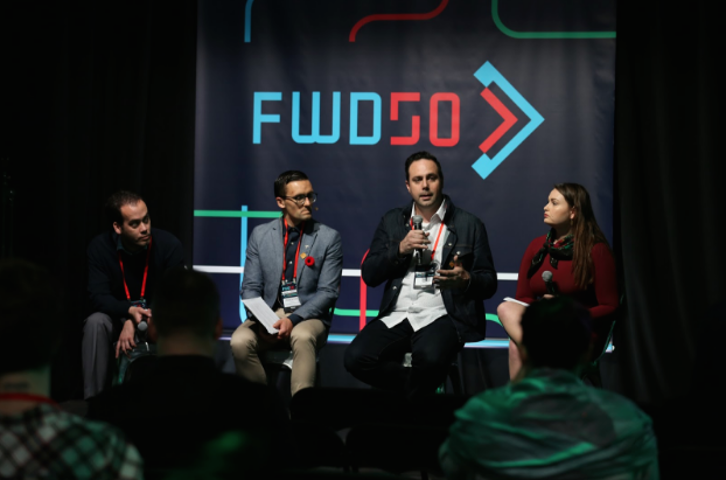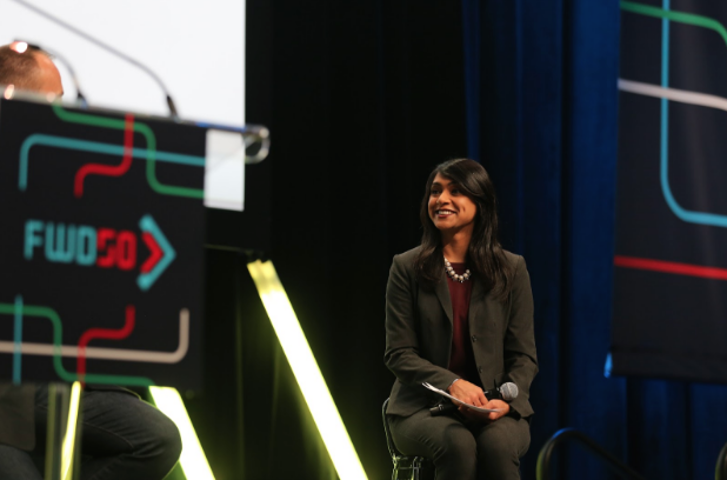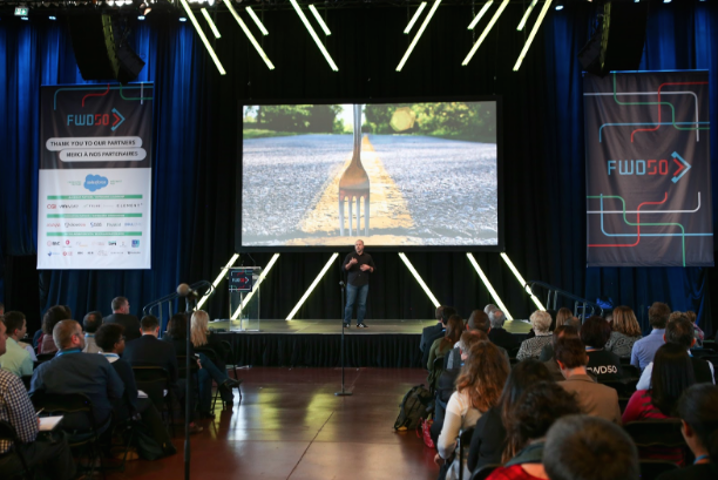On October 11 of this year, Canada relaxed the rules on what it takes to become a Canadian citizen. The new requirements — part of a broader set of changes under Bill C-6 — mean that the path from permanent residency to citizenship is now considerably shorter.
These changes mean that a swathe of residents are suddenly newly qualified to take their citizenship test. This writer is one of those people.
Two things fully-fledged Canadian citizens can do that permanent residents can’t: vote, and run for office. Both are of interest to me. But before I take a weirdly outmoded pledge, pick a party and begin plotting an elegant segue from tech into politics, it seemed wise to do a bit of digging…
To that end, I’m in Ottawa for FWD50 – Canada’s digital government conference. My goal? Find out what’s what and who’s who in the world of Canadian government innovation, and see if this country I’m so fond of truly has it together when it comes to creating an inclusive future for all its citizens.
Day one: “The Canadian government has a new value proposition”
The weather in Ottawa is totally grim. Although, not quite as grim as my choice of hotel. (Protip: Avoid the Best Western on O’Connell unless your aesthetic of choice is microwave-meal bleak.) But the conference venue – Aberdeen Pavillion in Landsdowne Park – is charming. Nice and warm too, thanks to the space heaters hanging from the ceiling.
“There is no silver bullet for partnering with the public sector. It’s not for the faint of heart.”
Every Canadian should have the opportunity to do business with the government of Canada. So says Desmond Gray, Director General of the Office of Small and Medium Enterprises. His team is responsible for connecting Canadian companies (>500 people) with the $5.5 billion designated annually for the government purchase of goods and services from Canadian SMEs.
He describes his team as leaders within government when it comes to fully embracing digital transformation. And it does sound like they’ve been drinking from the startup thinking drinking fountain. He’s using words like value proposition.
Canada, Gray says, has “shifted its value proposition – to offer social and economic benefits for all Canadians.” (I couldn’t, however, quite fathom what it was supposed to be before.)
“The government has shifted its value proposition. We deliver social and economic benefits for all Canadians.”
Gray’s office has been listening to SMEs to learn how to better bridge the gap between the public and private sectors. They heard that existing procurement processes were excluding smaller, more nimble companies because of a process that is lengthy, complex and without clear timelines.
If you’re hoping to sell to government, here’s some of the tips that were shared:
- Use buyandsell.gc.ca to explore opportunities and download data from past procurements.
- Their team can also help connect you with the thousands of smaller contracts (>$2M) awarded annually that aren’t posted on the site.
- As sellers, we can be better by including our product teams earlier in the bidding process so that we’re proposing authentically possible solutions.
The Buy and Sell site also now posts challenges that ask companies to respond to a particular problem. There’s 10 fresh ones going live in November, with more to come.
From this writer’s vantage point, that shift towards challenge-based procurement has real potential. The challenge model invites us to submit our own solutions to problems posed, rather than demanding a response to a specific and rigid set of requirements.
This is far more in line with the way entrepreneurs actually want to work. But, there’s an unavoidably large chasm to cross here. A handful of challenges posted monthly isn’t exactly compelling when you consider the volume of public-private sector transactions happening annually. To date, it seems that there is just a single tangible example of agile procurement in action: a website project from the Open Government Implementation team.
Canada’s Digital Divide exists, and is exacerbated through unequal access to opportunities.
One entrepreneur attending the conference urged caution, saying it’s unlikely his team would work with government, despite these changes. As a founder of a successful 40+ person software company, he argued that these first steps are good, but that “much more challenging cultural changes will need to happen to enable constructive engagement leading to positive long-term outcomes. Policy has a habit of being worked around.”
Lisa Carroll, a Senior VP at CGI who spoke about her experiences collaborating with 95+ federal departments on IT projects, warned there is “no silver bullet for partnering with the public sector. It’s not for the faint of heart.”
But entrepreneurs aren’t known for being a faint-hearted bunch. This is an ambitious undertaking, requiring a major perspective shift for government teams. Getting there will require plenty of will, patience and vocal engagement from private sector innovators too.

Day two: Canada needs a more global perspective
In evaluating Canada’s efforts when it comes to digital transformation, it’s useful to look beyond our borders to see what’s up in other parts of the world.
Siim Sikkut is the CIO of Estonia, and one of the architects of the country’s e-residency program. With a population of just over one million people, Estonia is a tiny country doing mighty things when it comes to digital government. In his talk — Behind The Scenes of the Estonian Miracle — Sikkut shared some of the things they have achieved.
- Every single interaction an Estonian citizen has with the government is digitized, and managed through a single ID. The only exceptions are marriage, divorce, and property sales.
- Voting is 100 percent digital. They tackled the problem of corruption/coercion by allowing citizens to re-submit their vote as many time as they like.
- As a citizen, you control your data. You can see who is accessing your data (medical records, for example), when and why.
- Legislation became an effective tool for implementing these policies. It is illegal for the Estonian government to ask a citizen for a piece of data more than once.
Of course, you don’t have to be running your own a country to get some tips here. Replace “citizen” with “customer” and think about how you could apply some of this to your own data collection activities.
Sikkut also extended the invitation to join Estonia’s E-Residency program. 3,700 companies have already been started by e-residents, and you can check out this dashboard to learn more about who’s already applied.
“We think about country-as-a-service. If your government doesn’t offer you good digital services, go abroad,” said Sikkut.
The government is learning, slowly, that not all of their investments will have immediate returns and obvious ROI.
Also taking the stage was Robyn Scott, CEO and co-founder of Apolitical, where she shared case studies of civic innovation from around the world.
Apolitical’s mission is to help public servants innovate by connecting them to smart policies and the people behind them. Their free P2P platform is used by members in 99 countries, and is open to public servants, foundations, and innovation partners.
(I signed up.)
Scott emphasised that business people always underestimate is how tough it is to get anything done in the public sector. Serving citizens whilst managing complex stakeholder relationships is, like, really, really hard. We need to get better at understanding this, so we can be effective co-designers from the outset.
She also urged public servants to learn from how businesses behave and start paying more attention to what’s happening in other markets. Analyzing competitors and comparables comes naturally to those in the private sector. But only one government in the world — China — routinely evaluates other government programs as part of their policymaking process.
Check out these awesome policy and tech innovation examples:
- This anti-corruption app from Columbia that used citizen’s contributions to identify $163 million of neglected public works projects.
- This roof rental project in Gujarati, where citizens lease roof space to the government to place their solar panels
- And this rape reduction program from Nairobi that slashed rape rates among adolescents by 51 percent
The Apolitcal team is also gearing up to launch a showcase of the world’s top #govtech startups, so watch out for that coming down the pipes.
My read on this: As we move towards a world where governments compete to offer digital services to global constituents, this isn’t just a matter of accelerated learning for this government. It’s a critical factor for relevancy in today’s world.
Here’s something else critical for relevancy in today’s world: Fixing your face when it comes to your indigenous communities. I’m talking to you, Canada.
Canada is known worldwide for its inclusiveness, diversity, and progressive attitudes. The world’s policymakers consistently look to Canada for inspiration. So it’s like, extra shameful that the UN had to drag you over the coals for actual human rights violations not too long ago.
One of FWD50s most important conversations was the Indigenous Access Panel, moderated by Mark Taylor with speaker contributions from Gabrielle Fayant, Jeff Ward, and Alexander Dirksen.

The panelists spoke about a need for us to be co-creating solutions within a nation-to-nation framework, rather than applying patriarchal, colonial ways of behaving to conversations between settlers and indigenous communities.
“We think about nation-to-nation relationships, yet one nation has to report to the other on financials etc,” said Ward, founder of Animikii. “Government requires use of particular data systems – data sovereignty is part of nations move to sovereignty.”
The panelists called for us all to pay more attention to ancient Indigenous knowledge and ways of being. Indigenous peoples, they reminded us, are this land’s original technologists. As creators of innovations in agriculture, housing and more, it was their technology that allowed the first colonial settlers to Canada to survive.
They also touched on a couple of important themes I would have expected to play a more prominent role at FWD50 overall, but didn’t see discussed (at the sessions I attended).
- We should be concerned about the influence of the so-called “frightful five” – Amazon, Apple, Facebook, Microsoft and the Goog.
- We’re all accountable when it comes to being vigilant here, and remember that it is in our most underserved communities where the effects of their behaviour will be amplified.
Canada’s Digital Divide exists, and is exacerbated through unequal access to opportunities. Access to fit-for-purpose internet is a human right, and it’s the poorest communities in remote and rural areas that are least-served. Lack of innovation isn’t the constraint for indigenous people, said Fayant. The barrier is access.
The day closed with a conversation between FWD50 Curator Alistair Croll and Bardish Chagger, the Minister of Small Business and Tourism.
Read: Minister of Small Business and Tourism Mandate Letter
Chagger recognized that Canada does have connectivity challenges in rural areas, and that more needs to be done to support underrepresented business owners: women, newcomers, young people, and indigenous groups. The main challenge, she says, is making sure people know about the support that’s available to them.
“We have bookshelves full of products, services, and programs. What’s lacking is people USING those products and services,” she said. “Some of the processes in place for accessing those opportunities are ridiculous.”
That’s where smart tech can start doing the heavy lifting. When every business has a number, shouldn’t we also be able to use that number to see what services are right for us at our stage of growth?
The Minister also pointed to some new and upcoming improvements to government support for small businesses:
- CANEXPORT matches Canadian products and services with global opportunities, connecting entrepreneurs with the right people in those markets to make it happen.
- The Accelerated Growth Service – still in pilot phase – is designed to seek out and support high-impact Canadian companies and help them grow.
- And coming soon is the results of a Horizontal Service Review that will inform the roadmap for digital government to business interactions.
The government is learning, slowly, that not all of their investments will have immediate returns and obvious ROI. And what they need, Chagger says, is for entrepreneurs to be vocal advocates about what will help them most. Her door is open, and she promises to respond if you write her a thoughtful note. (Here’s her email address if you feel like taking her up on that).

Day three: Defining the future
My favourite new discovery from the final day of FWD50 was definitely the Field Innovation Team. Led by Desiree Matel-Anderson, FIT empowers humans to create cutting-edge solutions in disaster situations. In practice, that means deploying volunteers to disasters across the globe to solve problems around communication, volunteer management, and more using a three-step design thinking framework that engages citizens, NGOS and local governments. Sign me up.
The Code for Canada team were also in the house to introduce us to their program and share information about how to get involved.
I’m all about the Code for Canada model, which matches governments with talented product people to create digital products and services with measurable impact. Over a 10-month period, Code for Canada’s Fellows (the aforementioned product people) embed with a government team. The goal is to create sustainable solutions, but also to catalyze culture change and transfer knowledge.
“Digital transformation is complex,” said Dorothy Eng from Code for Canada. “A myriad of things need to happen at the same time for it to be successful – generating small wins, getting buy-in, talent access, and a human-centered/agile approach. The Fellowship is a pilot that accelerates all these things so you can make a case for these changes.”
One of the core takeaways is that we in the private sector need to be active and patient contributors here.
This concept is relatively new to Canada. But it’s a mature model for digital transformation that’s already showing success in other countries. Examples include California’s Get CalFresh, which allows citizens to apply for food stamps in just ten minutes, and Mapaton CDMX out of Mexico City, a mobile game incentivizing users to submit public transit data. This project enabled the city to create their first ever map of public transit routes.
Code for Canada is part of the global Code for All network, and has been able to learn from their international forerunners to create a model for Canada.
So…how can you get involved?
Code for Canada is planning to run two cohorts in 2018, with at least two government partners for each cohort. It’s a full-time, paid program for Fellows ($75,000 a year), and those interested in applying should check their site for more details.
For government teams, the program costs $450,000, which covers training, team expenses, and operating costs. Code for Canada needs four to six months lead time to help shape the project and recruit the right Fellows. For that investment, Code for Canada says, you’re not just getting a new product or service delivered. You’re getting a swat team that can teach your whole team about better ways to build.
Closing out the conference was Alex Bernay, CIO of the Government of Canada. A classic “no-holds-barred” disruptor archetype of a guy, he delivered some tough love to the government people in the room about the necessity of culture change.
“In ten years time, people will judge us so harshly if we don’t do something completely different now,” Bernay said. “We’re the biggest employer and the most data-rich organization in Canada, yet we’re still talking about websites. We should be talking about ‘country-as-a-service.’
If we don’t revisit and evolve our business models, citizens will seek to fulfill their needs elsewhere. We need to get more private sector people in share their experiences, and it shouldn’t take 16 months to make that happen. We need bigger, bolder digital policies, and more disciplined execution.”
He also shared insight into what he called ‘the biggest IT policy refresh in a decade.”
- By February: There will be a single digital policy for government
- By March: Open source will be a part of government architecture standards
- By April: Mandatory architecture reviews, cloud-first as standard, accessibility by default
- Government teams can create SaaS solutions for protected data now. The policy coverage, procedures and standards are all in place.
- Agile, open procurement is now possible
Basically, no more excuses. It’s time to get on with it, because the alternative is irrelevancy.
Conclusions
It seems like the early days when it comes to creating a world-class Canada from a digital perspective. As a service user, I can attest that there’s a long way to go when it comes to realizing the vision of a country that is as celebrated for its tech wherewithal as it is for its values.
I asked Hillary Hartley, Ontario’s Chief Digital Officer, to comment on the state of things, drawing on perspective gained from worked in both the US and Canada. Encouragingly, she says that both the willingness and the readiness is there for digitally transforming government in Canada.
One of the core takeaways is that we in the private sector need to be active and patient contributors here. The Canadian government is listening to us. And not in a spooky Amazon Echo way. In a newly agile way. And the reward is compelling: more opportunities to co-create solutions to society’s biggest challenges together.
The proof of the pudding will, of course, be in the eating. I’m pretty sold on this whole government thing, and it was neat to see a consistent through line from Ministerial messaging down to the early examples of practical agile procurement and product delivery.
I’m game to give it a year. If this event was all about hitting the reset button for an inclusive digital future in Canada, let’s check in at the next FWD50 and see if the promise of a more collaborative, more open, more tech-centric government is legit.

Affiliations & Acknowledgements
- Holly Knowlman is a Canadian Permanent Resident and British Citizen. She hopes to become both a Canadian Citizen and an Estonian E-Resident
- Her employer is TWG, an independent digital product studio that would love to co-create solutions in partnership with governments
- Thank you to the FWD50 for creating and curating this event, to all the speakers and attendees who shared their perspective, and to Betakit for publishing this piece
- This piece was produced on land which is the traditional and unceded territory of the Algonquin nation. Thank you.
The opinions expressed in this article are the author’s own and do not necessarily reflect the views of BetaKit.


